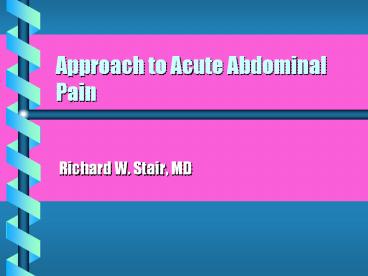Approach to Acute Abdominal Pain - PowerPoint PPT Presentation
1 / 24
Title:
Approach to Acute Abdominal Pain
Description:
Approach to Acute Abdominal Pain Richard W. Stair, MD Acute Abdominal Pain Approximately 5-10% of ED visits 5 million visits annually Most common diagnosis is ... – PowerPoint PPT presentation
Number of Views:1248
Avg rating:3.0/5.0
Title: Approach to Acute Abdominal Pain
1
Approach to Acute Abdominal Pain
- Richard W. Stair, MD
2
Acute Abdominal Pain
- Approximately 5-10 of ED visits
- 5 million visits annually
- Most common diagnosis is nonspecific abdominal
pain ( ie, I dunno!) - Sex and age shift the likelihood of certain
diagnoses
3
Abdominal Pain for the AgesCommon Etiologies
- 0-2 years - colic, gastroenteritis, viral
illness, constipation - 2-12 years - appendicitis, functional disorders,
gastroenteritis, constipation, viral illness,
toxins, UTI - Teens - as in 2-12 plus dysmenorrhea, PID,
Mittleshmerz, pregnancy, ovarian cyst
4
Abdominal Pain for the AgesUncommon Etiologies
- 0-2 years - Hirschsprungs disease, incarcerated
hernia, intussusception, malabsorption,
appendicitis, volvulus, milk allergy - 2-12 - CF, DM, IBD, Meckels diverticulum,
ovarian/testicular torsions - Teens - colitis, DM, endometriosis, epidydimitis,
cholecystitis, IBD, torsion
5
BEWARE - Abdominal Pain in the Elderly
- Many more vague presentations
- Comorbid diseases
- Morbidity and mortality rise EXPONENTIALLY after
age 50 - Twice as likely to need surgery after age 65
- Diminished pain sensation
6
Acute Abdominal Pain and Sex
- Men more frequently seen in the ED, and more
likely to have a perforated viscus - Women are more likely to have cholecystitis,
diverticulitis, and be D/Cd with nonspecific AP
7
Whats the Problem
- Imprecise pain generation and transmission to the
CNS - Comorbid diseases, developmental stage of
patient, medications, social factors - The key is understanding types of pain
- visceral
- somatic
- referred
8
Visceral Pain
- Generated by stretch receptors in the walls of
hollow viscus and the capsules of solid organs - Fibers return to various levels of the
sympathetic trunk on BOTH sides of the spinal
cord - Poorly described, achy, crampy, diffuse
9
Visceral Pain
- Levels of visceral innervation
- C3-5 - liver, spleen, diaphragm, pericardium
- T5-9 - gallbladder, stomach, pancreas, small
intestine - T10-11 - colon, appendix, pelvic viscera
- T11-L1 - sigmoid colon, renal capsules, ureters,
testes - S2-4 - urinary bladder
10
Somatic Pain
- Fibers arise from the parietal peritoneum, the
rrot of the mesentery, and the anterior abdominal
wall - Innervation corresponds to dermatomes entering
cord unilaterally - Usually sharp, well localized
11
Referred pain
- Caused by overlap of nerve fibers from different
locations returning to the spinal cord at the
same area - Pain sensed distal to site of problem
- Example - L shoulder pain with ruptured spleen,
remember spleens capsular fibers enter cord at
C3-5
12
Abdominal Pain - HistoryThink OLD CARS
- O - onset
- L - location
- D - duration
- C - character
- A - aggravating/alleviating factors,
- associated symptoms - R - radiation
- S - severity
13
History - More Info
- PMH - prior episodes prior medical conditions
making some diagnoses more common - PSH - adhesions 1 cause SBO
- Medications - NSAIDS, Abx
- Social - drugs, withdrawal, foreign bodies
- Gyn/Urol - timing of periods, bleeding,
testicular pain, bloody urine
14
Physical Exam
- VITALS
- General - appears sick or in obvious pain
- Inspection - bruises, scars, distension
- Auscultation - hyper, normal, none
- Palpation - pain vs. tenderness
- start away from painful area, guarding, etc
- Extra-abdominal exam
15
Physical Exam Signs
- Murphys
- Rovsings
- Iliopsoas
- Obturator
16
Ancillary Tests
- CBC - lacks sensitivity and specificity
- Labs should be DIRECTED
- Urine dipsticks
- Urine hCG
17
Imaging
- Plain films - obstruction, free air, air-fluid
levels, foreign bodies - CT scanning
- Ultrasound
- Nuclear medicine scans (HIDA)
- Endoscopy
18
DDx - RUQ pain
- Pneumonia
- PE
- hepatitis
- cholecystitis
- biliary colic
- PUD
- Pancreatitis
- renal stone
- pyelonephritis
- retrocecal appendix
- heart failure
- MI
19
DDx - LUQ pain
- Gastritis
- gastric ulcer
- pancreatitis
- renal stone
- pyelonephritis
- Pneumonia
- PE
- splenic rupture
- splenic enlargement
- diverticulitis
20
DDx - RLQ pain
- Appendicitis
- cholecystitis
- diverticulitis
- renal stone
- AAA
- mesenteric adenitis
- regional enteritis
- Meckels diverticulum
- Testicular torsion
- epidydimitis
- salpingitis
- ectopic pregnancy
- ovarian cyst
- Mittleschmertz
- TOA
- cystitis
- prostatitis
21
DDx - LLQ pain
- AAA
- renal stone
- diverticulitis
- perforation
- volvulus
- salpingitis
- ectopic pregnancy
- Ovarian cyst
- Mittleschmertz
- TOA
- cystitis
- prostatitis
- testicular torsion
- epidydimitis
22
Management of Acute Abdominal Pain
- IV access
- Fluids
- Emesis Control
- Analgesia
- Antibiotics
- Consultants
23
ACEP Clinical Policy on Acute Abdominal Pain -
Oct 2000
- Evidence based guidelines and options for many
Emergency Department presentation
24
Abdominal Pain - Disposition
- Operating Room
- Hospital Bed
- Home with abdominal warnings
- Remember to beware of the extremes of age































